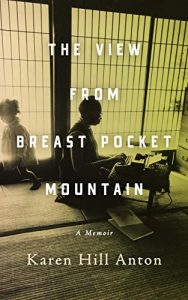The opening paragraph of Karen Hill Anton’s memoir conveys the promise of a well-written story full of powerful life lessons and inspirational anecdotes, despite the sadness on the first page. Anton explains how she was only nineteen years of age, but already traveling in Europe when everything she owned and valued was burned and ruined in a fire in the tenement apartment where she grew up in Harlem. Anton’s story blossoms and blooms into a delightful memoir covering themes dealing with motherhood, cross-culturalism and cultural homogeneity, courage, creativity, conventionalism, and liberalism, as well as love, loss, and the ability to endure the unbearable with patience and dignity.
Anton’s childhood was daunting. Whenever she sees brightly colored marigolds, she remembers visiting the mental institution where her mother lived full-time. She was raised by her father who worked long hours as a tailor, doing everything he could to provide for his children. This accomplished writer matures early. She delights the reader with stories of her work experience in her twenties in countries such as Denmark and Switzerland where she meets fascinating and famous people like Elizabeth Taylor and Richard Burton. She works sporadically while trying to raise her baby as she hitchhikes and rides second-class on trains, wandering from one country to another, before moving to Vermont in the US, “a place that embodies the ideas of a hippie revolution without the accompanying dysfunction.” (p. 89).
Anton’s love and respect for her father are transparent throughout the book. On page 8, she says she has inherited his generous smile. Some people just think about how much money they’ll inherit from their parents, but this kind-hearted author is grateful for her smile that reminds her of her dad every time she looks in the mirror or at a photo of herself. When she hears her father has been attacked and he’s in hospital, Anton rushes to his bedside. Her poignant words describing her distress evoke a keen sense of hopelessness and regret: “I’d never experienced tragedy before. I didn’t know the paradox of how it shows up with distinct, sharp, ugly lines, deep colors, and loud sounds, and then switches into lines that are blurred, vague, gray, and all sound comes through muffled.” (p. 83).
A visit to Boston reunites the writer with her friend and future husband, William (Billy) Anton. They share an interest in books and Zen Buddhism. Billy also introduces her to “the films of Kurosawa, natural foods, the philosophy of Bertrand Russell” (p.76) as well as macrobiotics, vegetarian cooking, and Japanese cutting techniques. (p. 79). Billy accepts an invitation to study at a yoga and martial arts dojo in Japan and the writer and her daughter Nanao decide to join him but first, they decide to take an unorthodox road trip through Europe and South Asia.
Anton expands on the importance of introducing her child to different cultures but she’s also well aware of the dangers and her worries prove she’s a thoughtful and capable mother. She senses that “even with her young eyes she’d see that people are basically alike—not in our cultures, surely, but in our humanity. And I hoped that she would see the world as I did, and find, as I had, that most people are kind and helpful and that the world we call Earth is a wonderful place full of endless lessons” (p. 154/155).
Nanao is five-years-old when they arrive at Haneda Airport in Japan to study at the Yoshida Yoga Doja. Finally, “we had our place in a group where nothing mattered more” (p. 141). This lifestyle which relies heavily on rules and mundane, repetitive order is just what they need after the uncertainty of constant traveling and not knowing where they were going to rest their heads at night.
Anton and Billy eventually get frustrated with the restrictions placed upon them at the dojo, and they move to a farmhouse on Futokoro Yama or Breast Pocket Mountain. Anton has an unfulfilled desire to start taking lessons in shodo Japanese calligraphy so she presents the honorable eighty-three-year-old teacher Roppo-sensei with a loaf of homemade bread to show her gratitude for being introduced. She’s immediately accepted into his group of willing students. Anton still practices the art of calligraphy today.
The writer remains positive, enjoying her days at the farmhouse and the kotatsu and ofuro bath in particular, but life becomes increasingly difficult. The isolation and lack of modern conveniences are exhausting. She also realizes that “I just had to accept the fact that at no time and nowhere would I go unnoticed” (p. 176) as a gaijin or outsider. However, the fact this farmhouse is mentioned in the title proves that Anton learns significant life lessons and enjoys memorable experiences here. A visit to a fertility expert at this time results in a quick pregnancy and she has a wonderful birthing experience thanks to Dr. and Mrs. Mizumoto who show her the difference between a hospital and great hospitality (p. 181).
The drawbacks at the farm become overwhelming and they decide to move when she’s heavily pregnant with her fourth child Lila into a house with imperial connections in Hamamatsu. “Empress Teimei – the mother of Emperor Shōwa, great-grandmother of the current emperor, Naruhito – had once spent a night there.” (p. 194).
Anton mentions several times throughout the book how much she enjoys the safety Hamamatsu and Tokyo have to offer and she loves the “equality of educational opportunity in this country” (p. 240). These factors are two of the main reasons for her staying in Japan and why she decides to raise her four children here.
Anton goes above and beyond to break down cultural barriers by talking at kominkan community centers in rural areas. She also teaches modern dance and continues to do this for 10 years. There’s a terrific photo on page 24 of the author dancing at George Washington High School. Her body is in flight mid-air, defying gravity, and her face expresses a look of quiet exhilaration. Anton has also written several regular columns for The Japan Times, including “Hamamatsu Highlights” and “Crossing Cultures”. She offers sound advice to anyone living in Japan, explaining the ways she has learned to fit into Japanese society. “I had no desire to be seen as Japanese or even acting Japanese. I would stand out in Japan, always. But I could also fit in. (p. 216).
Anton stresses the fact you don’t need to be perfect in Japan as a mother. Living in the Land of the Rising Sun can be stressful if one is constantly comparing oneself with Japanese women who seem to be able to carry out life’s challenges flawlessly. Anton has learned to fall into line and to adopt the attitude “Do it now and get it over with” (p. 219) when it comes to school rules and requirements. Her life motto is “I’ll deal with it when I get there” (p. 134), making her a courageous and unstoppable force for good. But it’s Japan and the Japanese people who have taught her and her children that depending on others and interdependency is natural and “it supports the smooth functioning of society, and is crucial for our species”. (p. 278).
The Japanese have a proverb “The bamboo which bends is stronger than the oak which resists” or「竹はよわく弯がるが木は剛く立つ」. This book proves that Karen Hill Anton has taken this to a whole new level. Every day, she tries to live her best life with an open and flexible heart. When she faces a difficult task, Anton makes compromises while she tirelessly attends to the needs and wants of her family and friends and the people she meets along the way in Japan or in one of the many countries she has visited along the way.












